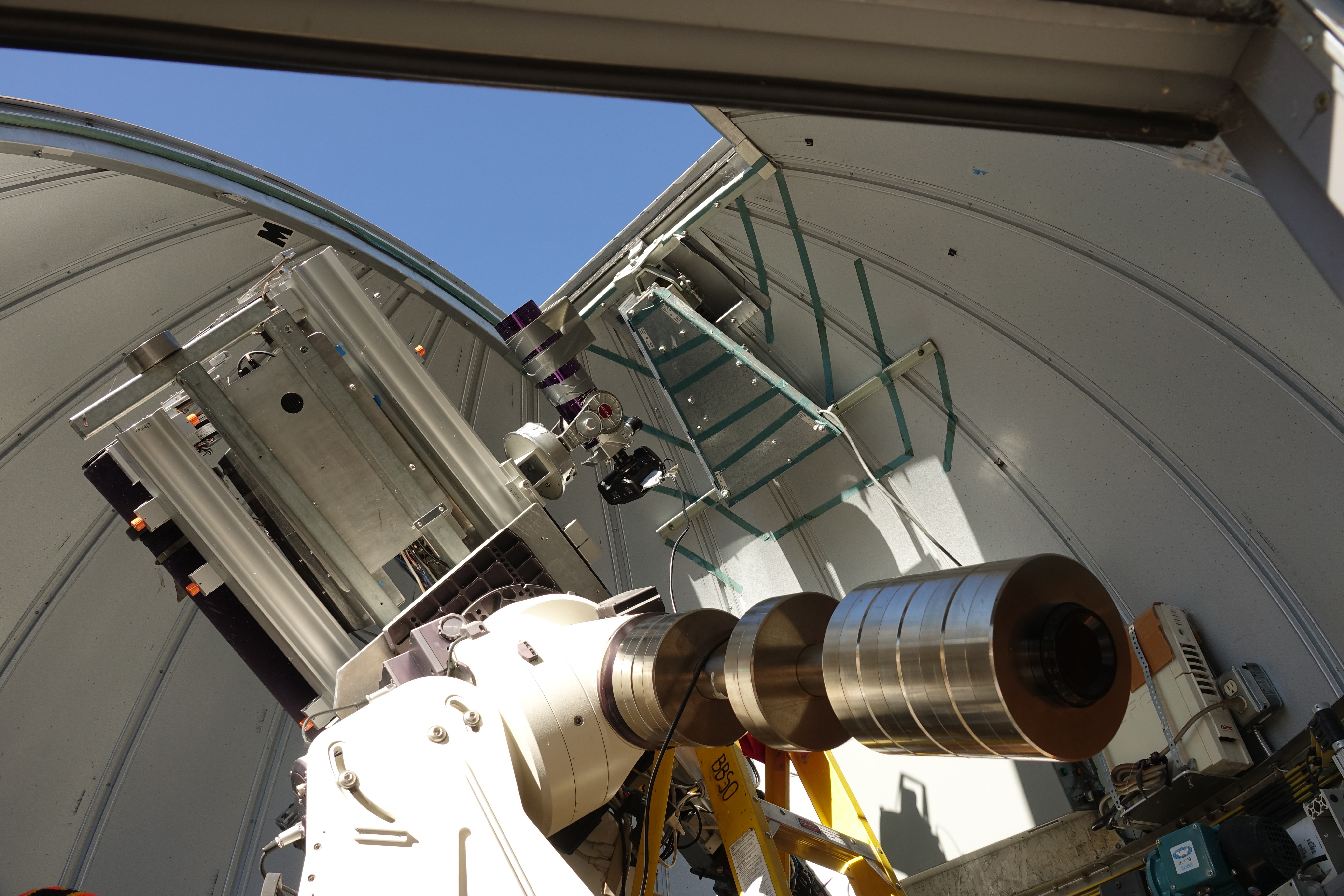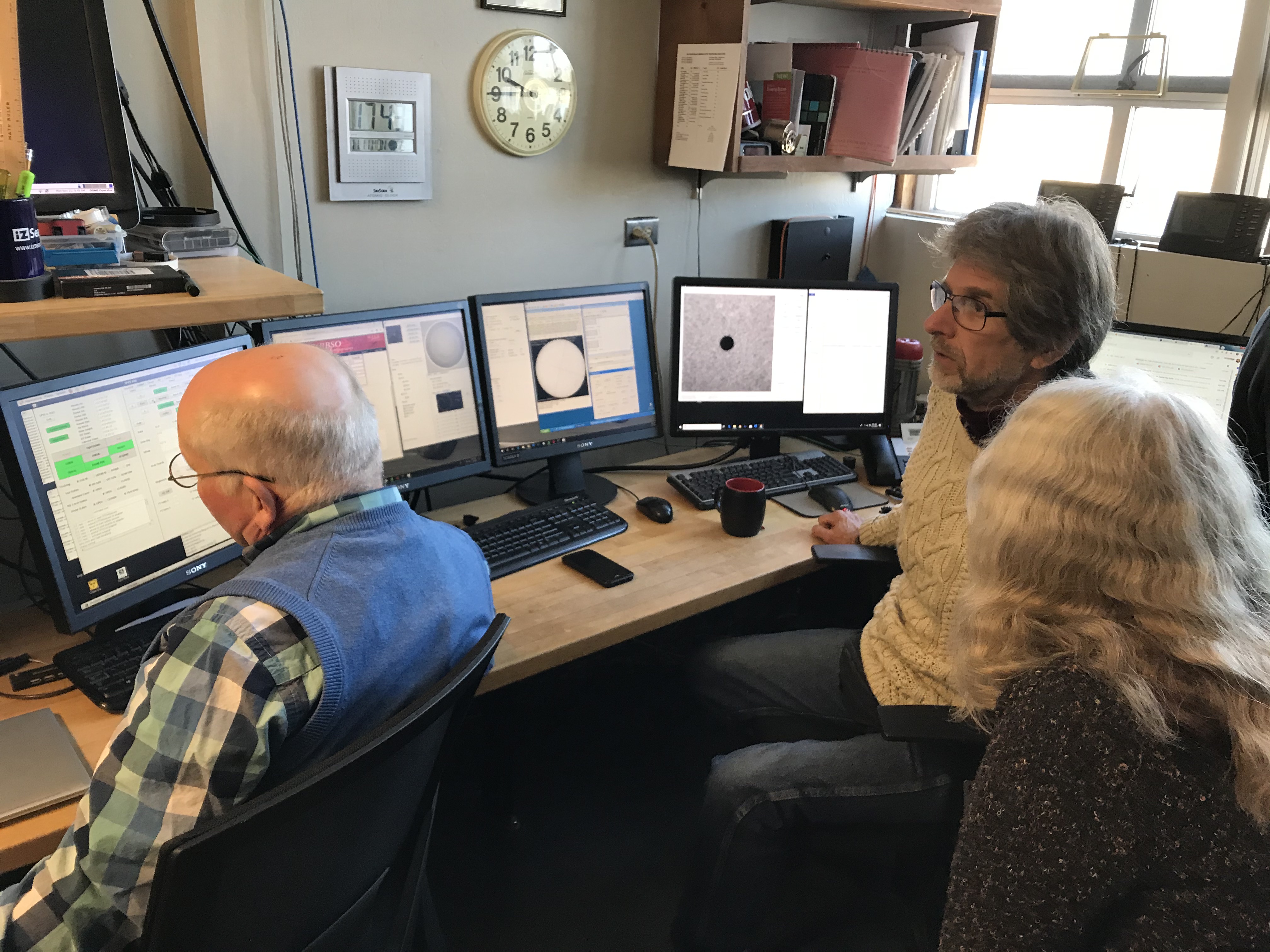Return to: Big Bear Solar Observatory (BBSO)
Big Bear Lake, California
Latitude: 34° 15.505' N, Longitude: 116° 55.278' W, Altitude: 2060 m
Glenn Schneider (Steward Observatory, The University of Arizona)
in collaboration with Jay Pasachoff (Williams College)
With sincere thanks for the help and accommodation by the staff at BBSO.
("People pictures" [non-transit photos on
this page] courtesy of Evan Zucker and Paula Eisenhart)
"Uninspiring" might aptly describe the blank canvas of the face of the Sun when fully devoid of any sunspots typifying its featureless appearance during the now-occurring doldrums of sunspot minimum in its 11 year cycle of solar activity. While such vast emptiness held on the morning of 11 November 2019, the uniformity of that nothingness was broken by a tiny dot too small to be perceived with the human (filter-protected) eye, but with even modest optical aid was seen in isolated silhouette against the background of the solar photosphere (see below). The "dot" being the diminutive planet Mercury, caught in the act at local sunrise near mid-solar transit from Big Bear Lake, California (and many other places blessed with clear skies on the Sun-facing side of the Earth).
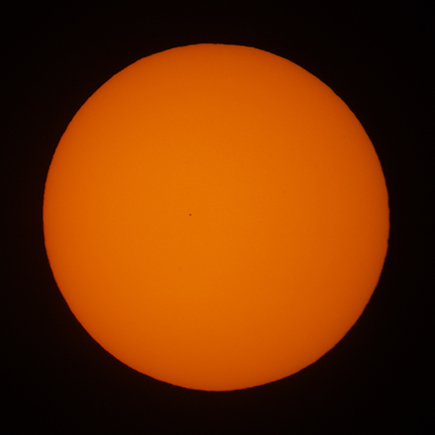
On an otherwise empty solar canvas, a first small-telescopic glimpse of diminutive MERCURY IN TRANSIT (look carefully!).
Low to the horizon and still at large air-mass at 144951 UTC.
(Photo: Questar 3-1/2", f/16, (EFL 1422mm), ISO 500, 1/500 s, Questar optical density 4.8 full aperture solar filter, Nikon D800)
Such Mercurian transits aren't
particularly rare, occurring on average 13 to 14 times per
century, but when they do occur they are fascinating events to
observe giving a visceral reality to the workings of celestial
mechanics in action. The last such event occurred only a
short 3-1/2 years prior, and was observed then by a small
group of us using the facilities of the Big Bear Solar
Observatory, home of the 1.6-meter diameter adaptive optics
(AO) solar telescope formerly known as simply the "New Solar
Telescope", but recently re-christened as the Goode Solar
Telescope (GST). Click HERE
for a description of that facility and happenings there during
the advent of that most recent prior the Transit of Mercury
(ToM) in 2016.
The geometrical circumstances and region of
visibility of the 11 November 2019 transit (see Appendix) from
Big Bear enabled a return visit for follow-on time-resolved
high-resolution AO imaging and visible/near-infrared
solar-back-lit spectroscopic observations of the extremely tenuous
Mercurian exosphere, and the (partially concurrent*) use
of small telescopes and cameras for visible "white light" and
Hydrogen-alpha imaging. With the transit well underway
at sunrise, contacts 1 and 2, and most of the first-half of
the transit would be out of reach. Our focus, thus, was on the
correspondingly latter portions of the transit, and of egress
through C3 and C4. *Because of its operational minimum
elevation angle restriction of ~ 23° above the horizon, solar
acquisition and AO-lock with the GST were limited to
approximately the last hour and a quarter of the transit
only.
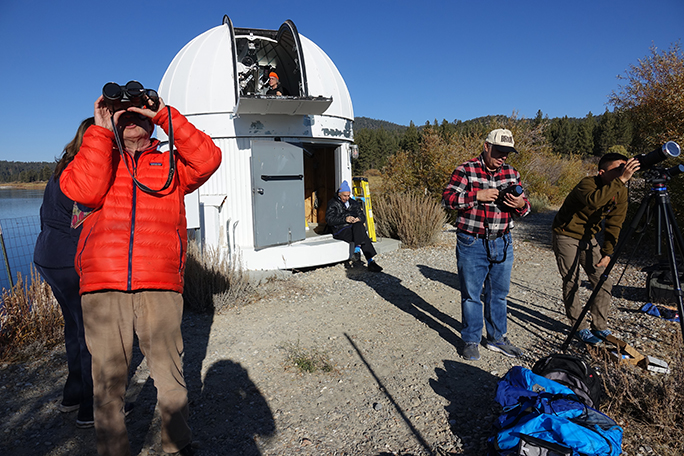 Near-horizon views to the east (right) permitted mid-transit visual observations on the observatory access road a few degrees above the horizon. A 3-1/2" white light Questar telescope in the small dome, parallel mounted on a 4" H-alpha telescope spar, acquired the transit at 6° elevation (photo up top). |
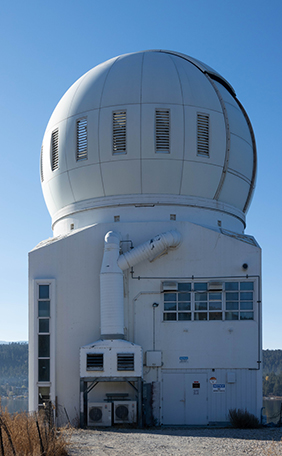 Observations with the 1.6
m GST
AO telescope began at 16:45 UTC
with the
Sun above the ~ 23° pointing limit. |
TRANSIT – 1.6m Goode telescope with
Adaptive Optics Wavefront Correction
|
Speckle-Reconstructed AO
Imaging with the GST
 |
(Click HERE to view/download the Movie!) <-- To the left is the 1st
reduced frame of Mercury-in-transit seen in
high-resolution against the solar photospheric
granulation with the GST wavefront control system in
AO lock. Reduced frames then proceed with an ~ 6
s cadence until shortly after C4.
Imaging was done with a 10 Å wide TiO filter centered at 7058Å in the BBI (Broad Band Imager) instrument with a PCO-2000 high speed CCD camera. Details from John Varshik: - The PCO camera takes bursts of 100 frames in an interval of ~ 6 s from which the 70 best frames are saved and from which a single speckle-reconstructed frame is produced. - The speckle-reconstruction algorithm assumes the only thing changing in each 100 frame burst is the Earth's atmosphere, which clearly is not the case (given the relative motion of the background photospheric granulation w.r.t. Mercury). (N.B.: The thin concentric light and dark rings around the periphery of Mercury's disk are artifacts from the speckle-reconstruction algorithm.) --> Thanks to John Varshik, Claude Plymate, and the BBSO staff |
C3/Black Drop – Goode 1.6m telescope with
Adaptive Optics Wavefront Correction
A
minimal, but detectable, Black Drop signature is seen
circum-Mercurian image isophotes from the raw GST BBI
18:02:55 UTC frame (3 seconds prior to geometrical
C3/internal tangency predicted for 18:02:58 UTC); see
below. This display frame is stretched linearly over
an 8-bit imaging min-to-max dynamic range from 25 to 158
DN. The image is displayed with a contouring color
table that switches from orange-to-blue mid-scale. The
color table is modulated from min to max with 6.25%
intensity contours peak-to-peak. The small (purple)
isophotal extrusion along the point of internal tangency
connecting the slightly tear-dropped disk of Mercury and the
inwardly "dimpled" photospheric limb at that point is
evidence for a Black Drop effect. Compare, for
example, to Figure 6E of Schneider,
Pasachoff, and Golub, 2004 (Icarus, 168,
249).
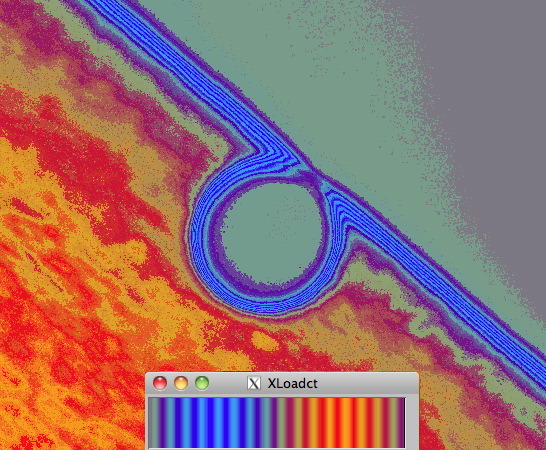
EGRESS - 0.089 meter (Questar
3-1/2") telescope with
natural seeing
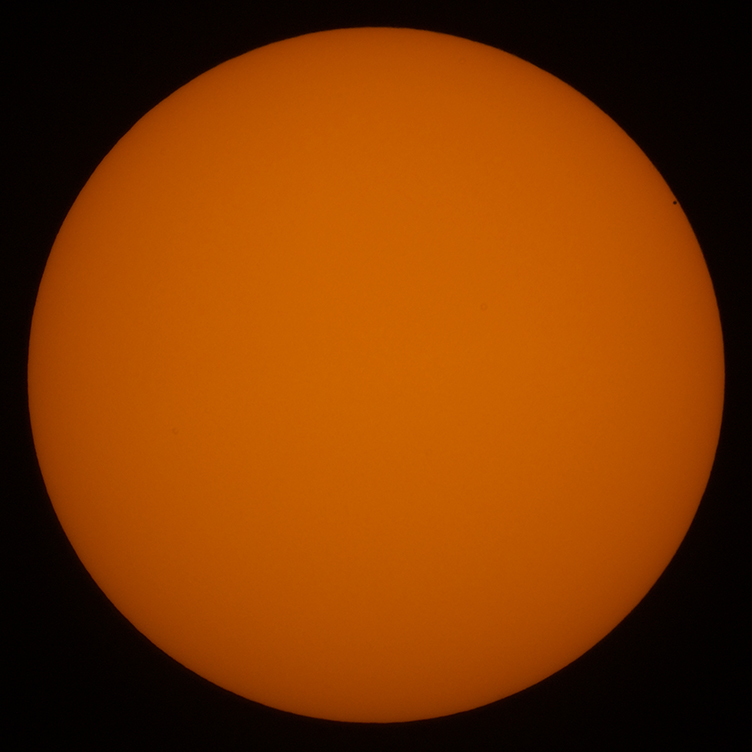

Full disk solar image at 18:02:22
(geometrical C3 - 36 seconds); Mercury at upper right.
(Photo: Questar 3-1/2", f/16, (EFL 1422mm), ISO 500, 1/1600 s, Questar optical density 4.8 full aperture solar filter, Nikon D800)
(Photo: Questar 3-1/2", f/16, (EFL 1422mm), ISO 500, 1/1600 s, Questar optical density 4.8 full aperture solar filter, Nikon D800)
| 180222 |
180240 | 180259 | 180309 | 180325 |
 |
||||
| 180340 | 180356 | 180411 | 180428 | 180440 |
Egress sequence: Top-left to bottom right
with corresponding UTC.
First frame same data as full disk image above.
Third frame at 180259 UTC is 1 s after predicted geometrical C3 with no evidence of Black Drop above the noise.
(Photos: Questar 3-1/2", f/16, (EFL 1422mm), ISO 500, 1/1600 s, Questar optical density 4.8 full aperture solar filter, Nikon D800)
First frame same data as full disk image above.
Third frame at 180259 UTC is 1 s after predicted geometrical C3 with no evidence of Black Drop above the noise.
(Photos: Questar 3-1/2", f/16, (EFL 1422mm), ISO 500, 1/1600 s, Questar optical density 4.8 full aperture solar filter, Nikon D800)
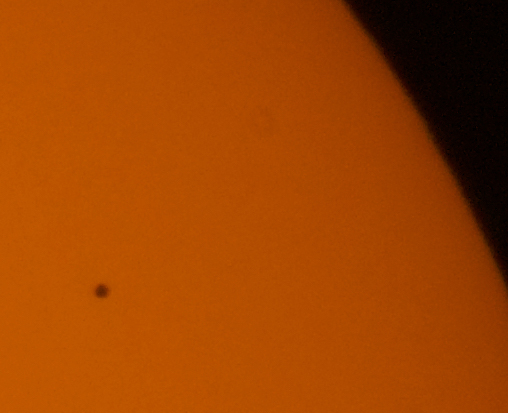
First frame from an extended egress Time-Lapse
"Movie" from 172114 (shown above) to 180440 UTC
Click HERE to view/download the Movie!
Frames 172114 to 175743 UTC cadence ~ 5m per frame, 175743 to 180440 UTC cadence ~ 15s per frame
"Playback" rate: 1 fps.
Click HERE to view/download the Movie!
Frames 172114 to 175743 UTC cadence ~ 5m per frame, 175743 to 180440 UTC cadence ~ 15s per frame
"Playback" rate: 1 fps.
The "Crew" and Memories of the Transit
(click on any picture to "enbigenate")
(click on any picture to "enbigenate")
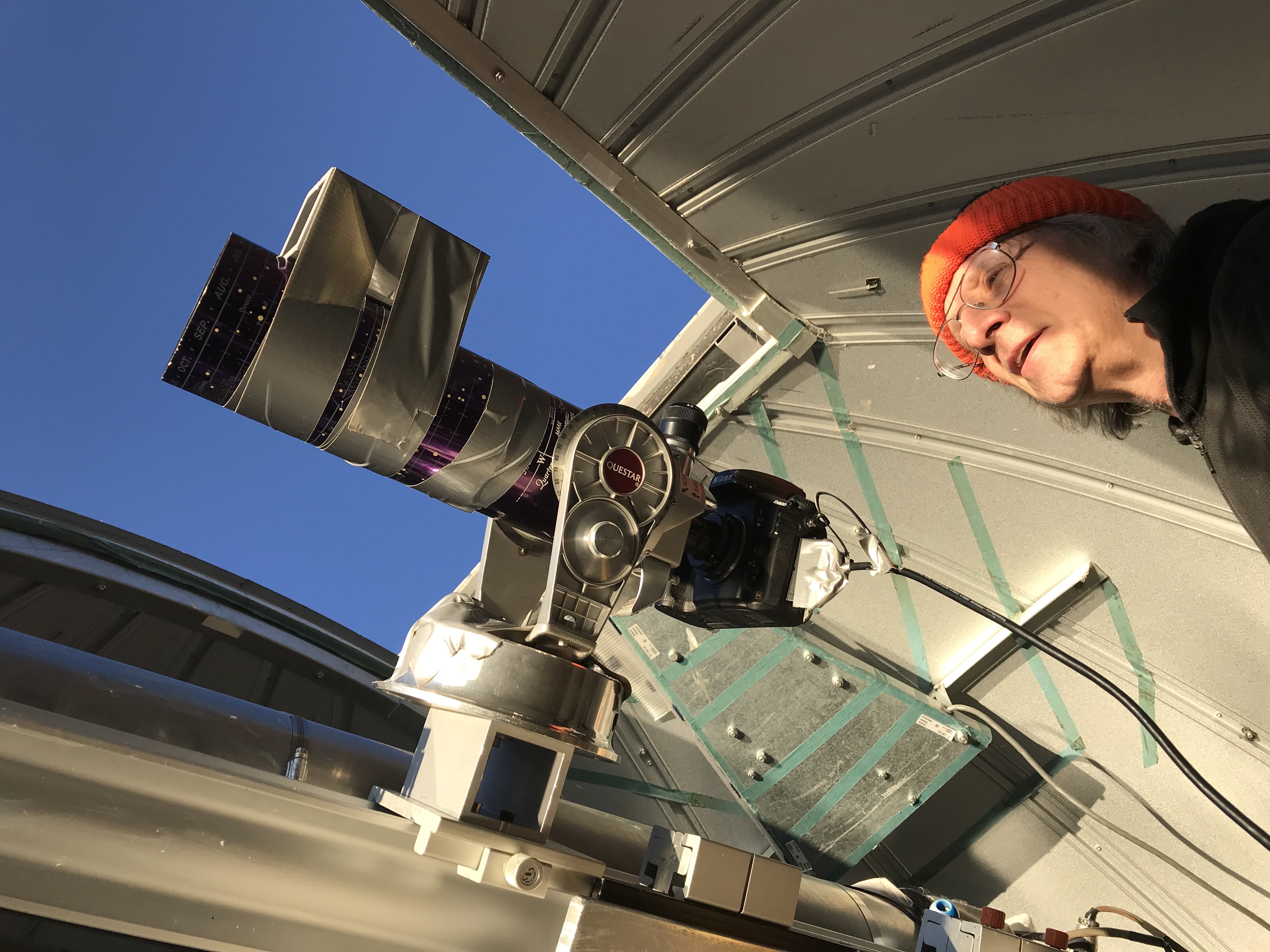 |
| Duct Tape – Never Leave Home
Without It! |
Appendix – Topocentric Circumstances of the
Transit from BBSO
BBSO Coordinates: 34.2584° N, 116.9213° W (34° 15' 30", 116° 55' 17")
BBSO Altitude AMSL: 2,060m (6,760 ft)
Angular Diameter of Sun: 1938.592" (@sunrise); 1938.712" (@ C4)
Angular Diameter of Mercury: 9.955" (@sunrise); 9.949" (@ C4)
Topocentric Transit Event Circumstances
EVENT* PST UTC ALT. AZI.
SUNRISE 06:18:18 14:18:18 -0.5° 110.8° P Z
MAX** 07:20:26 15:20:26 11.0° 120.1° 24.2° 288°
C3 10:02:58 18:02:58 34.1° 154.2° 298.6° 39°
C4 10:04:39 18:04:39 34.3° 154.7° 298.6° 39°
* Contacts 1 and 2 not visible (occur before sunrise)
** Impact Distance at MAX = 74.7"
Topocentric
Track from BBSO: Sunrise to C3

RETURN to Glenn Schneider's Home Page





